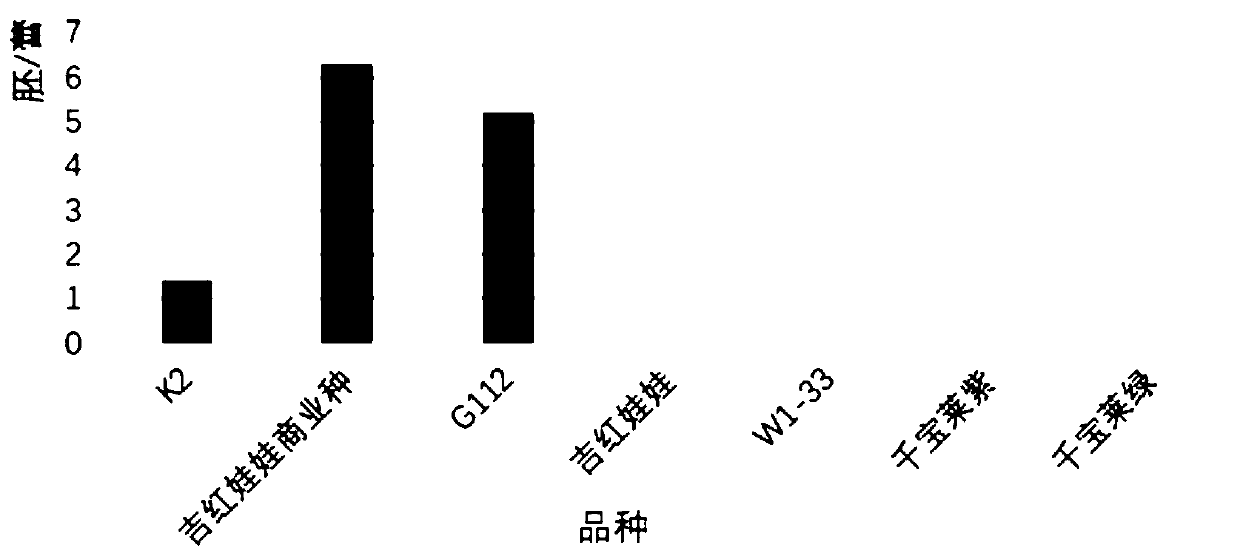Method for cultivating non-heading Chinese cabbage microspore plants
A technology for headed cabbage and microspores is applied in the field of cultivating non-headed cabbage microspore plants, and can solve the problems of low embryo rate, pollution, cumbersomeness and the like
- Summary
- Abstract
- Description
- Claims
- Application Information
AI Technical Summary
Problems solved by technology
Method used
Image
Examples
Embodiment 1
[0030] 1. Selection of flower buds: Collect samples from 9 am to 11 am, select flower buds with a ratio of petals to anthers close to 1:1, add a small amount of distilled water and store in a refrigerator at 4°C.
[0031] 2. Cultivate microspore embryos: Put the collected samples into a 2ml centrifuge tube, directly add 1% sodium hypochlorite for disinfection for 20 minutes, wash with sterilized water twice for 5 minutes each, and use 1 / 2NLN for the last time -13 for rinsing. Transfer the cleaned sample to the test tube of the sample grinding machine (German LKA control test tube disperser S025), add a small amount of 1 / 2NLN-13, and grind the sample to make the sample fully ground. Prepare a 50mL centrifuge tube, place a 40μm cell filter plug on top of it to filter, centrifuge, pour off the supernatant, then add NLN-13 to shake well, then centrifuge, pour off the supernatant, leaving a yellow-green precipitate. Then add a small amount of NLN-13 to the test tube and dilute to ...
Embodiment 2
[0034] Embodiment 2: the cultivation of microspores of non-heading Chinese cabbage of different varieties
[0035] Choose 7 different varieties (the commercial kind of Jihonghuahua, Jihonghuahua, G112, W1-33, Qianbaolai purple, Qianbaolai green, K2) adopt the method described in embodiment 1 to carry out microspore culture test, and count their Embryonic rate, compare the impact of this invention on the microspore embryonic rate. Among them, 'K2', 'Jihongwa commercial species' and 'G112' are embryo-producible varieties, 'Jihongwa', 'W1-33', 'Qianbaolai purple', 'Qianbaolai green' are not easy Embryo varieties. Such as figure 1 , such as comparing the results of embryo emergence, among the 7 selected varieties, the embryo emergence rate reached 42.8%, of which 3 varieties all emerged embryos, and the other four varieties did not emerge embryos.
Embodiment 3
[0036] Example 3: Effects of different concentrations of EMS on the microspore germination rate of non-heading Chinese cabbage treated at different times
[0037]The 'NHCC-224' with high embryo emergence rate was selected to study the microspore embryo emergence rate of non-heading cabbage treated with different concentrations of EMS at different times, as shown in Table 1, divided into three cases, the control and the same EMS Concentration and different treatment time, different EMS concentration and the same treatment time, by comparing with the control, it can be found that the low concentration of EMS has a certain promotion effect on the embryogenesis of microspores, the concentration is 0.04%, the time is 10 ~ 15min and the concentration is 0.08%. A time of 10 minutes is beneficial to embryogenesis. When the concentration of EMS is 0.08% and the treatment time is 10 minutes, it can obviously promote embryo emergence, which is about doubled. When the concentration of EMS...
PUM
 Login to View More
Login to View More Abstract
Description
Claims
Application Information
 Login to View More
Login to View More - R&D
- Intellectual Property
- Life Sciences
- Materials
- Tech Scout
- Unparalleled Data Quality
- Higher Quality Content
- 60% Fewer Hallucinations
Browse by: Latest US Patents, China's latest patents, Technical Efficacy Thesaurus, Application Domain, Technology Topic, Popular Technical Reports.
© 2025 PatSnap. All rights reserved.Legal|Privacy policy|Modern Slavery Act Transparency Statement|Sitemap|About US| Contact US: help@patsnap.com



